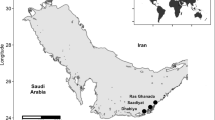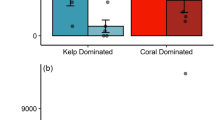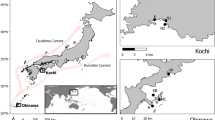Abstract
An assumption that a positive relationship exists between temperature and herbivorous fish grazing rates in coral reef environments has been used to explain seasonal and latitudinal trends in herbivore pressure. However, this assumption has not been systematically quantified over short-term (hours–days) changes in temperature, avoiding the confounding influences that can occur on seasonal or latitudinal scales. This study measured grazing activities of the pan Indo-Pacific parrotfish Scarus ghobban over short-term changes in temperature in upwelling and non-upwelling environments on the Pacific coast of Panamá. Individual juvenile fish were followed over naturally varying temperatures to determine their bite rates (bites min−1), the foray frequency (forays min−1) and bites per foray. In the upwelling environment, there was a significant positive correlation between temperature and bite rate (R Partial = 0.63, P < 0.0001) and there was a marked fourfold change in bite rates over the range of temperatures encountered in the study (21.2–29.4°C). Bites per foray were also positively correlated to temperature (R partial = 0.27, P < 0.0001), and tide height (R partial = 0.26, P < 0.001), whilst foray frequency was positively correlated to temperature (R partial = 0.63, P < 0.0001), but negatively to tide height (R partial = −0.31, P < 0.0001). The effect of temperature on grazing rates may explain differences in herbivore pressure across different thermal environments and may be a factor contributing to algal biomass increases in low-temperature coral reef environments.




Similar content being viewed by others
References
Bellwood DR, Choat JH (1990) A functional analysis of grazing in parrotfishes (family Scaridae): the ecological implications. Environ Biol Fish 28:189–214
Benayahu Y, Loya Y (1977) Seasonal occurence of benthic-algae communites and grazing regulation by sea urchins at the coral reefs of Eilat, Red Sea. Proc 3rd Int Coral Reef Symp 1:383–389
Boyer KE, Fong P, Armitage AR, Cohen RA (2004) Elevated nutrient content of tropical macroalgae increases rates of herbivory in coral, seagrass and mangrove habitats. Coral Reefs 23:530–538
Brawley SH, Adey WH (1977) Territorial behavior of threespot damselfish (Eupomacentrus planifrons) increases reef algal biomass and productivity. Environ Biol Fish 2:45–51
Bruggemann JH, van Kessel AM, van Rooij JM, Breeman AM (1996) Bioerosion and sediment ingestion by the Caribbean parrotfish Scarus vetula and Sparisoma viride: implications of fish size, feeding mode and habitat use. Mar Ecol Prog Ser 134:59–71
Carpenter R (1985) Relationships between primary production and irradiance in coral reef algal communities. Limnol Oceanogr 30:784–793
Carpenter R (1986) Partitioning herbivory and its effects on coral reef algal communities. Ecol Monogr 56:345–363
Choat JH, Clements KD (1993) Daily feeding rates in herbivorous labroid fishes. Mar Biol 117:205–211
Clifton KE (1989) Territory sharing by the Caribbean striped parrotfish, Scarus iserti: patterns of resource abundance, group size and behaviour. Anim Behav 37:90–103
Coles SL (1988) Limitation on reef coral development in the Arabian Gulf: temperature or algal competition? Proc 6th Int Coral Reef Symp 3:211–216
Conner JL, Adey WH (1977) The benthic algal composition, standing crop and productivity of a Caribbean algal ridge. Atoll Res Bull 211:1–15
Craig P (1996) Intertidal territoriality and time-budget of the surgeonfish, Acanthurus lineatus, in American Samoa. Environ Biol Fish 46:27–36
D’Croz L, Robertson DR (1997) Coastal oceanographic conditions affecting reefs on both sides of the isthmus of Panama. Proc 8th Int Coral Reef Symp 2:2053–2058
D’Croz L, Kwiecinski B, Maté J, Gómez J, Del Rosario J (2003) El afloramiento costero y el fenómeno de El Niño: implicaciones sobre los recursos biológicos del Pacifico de Panamá. Tecnociencia 5:35–49
Diaz-Pulido G, Garzon-Ferreira J (2002) Seasonality in algal assemblages on upwelling-influenced coral reefs in the Colombian Caribbean. Bot Mar 45:284–292
Done T (1992) Phase shifts in coral reef communities and their ecological significance. Hydrobiologia 247:121–132
Dunbar RB, Wellington GM, Colgan M, Glynn PW (1994) Eastern Pacific climate variability since 1600 A.D.: stable isotopes in Galápagos corals. Paleoceanography 9:291–315
Ferreira CEL, Peret AC, Coutinho R (1998) Seasonal grazing rates and food processing by tropical herbivorous fishes. J Fish Biol 53:222–235
Floeter SR, Behrens MD, Ferreira CEL, Paddack MJ, Horn MH (2005) Geographical gradients of marine herbivorous fishes: patterns and processes. Mar Biol 147:1432–1793
Fong P, Smith TB, Wartian MJ (2006) Epiphytic cyanobacteria maintain shifts to macroalgal dominance on coral reefs following ENSO disturbance. Ecology 87:1162–1168
Glynn PW, Stewart RH (1973) Distribution of coral reefs in the Pearl Islands (Gulf of Panama) in relation to thermal conditions. Limnol Oceanogr 18:367–379
Glynn PW, Maté JL (1997) Field guide to the coral reefs of Panamá. Proc 8th Int Coral Reef Symp 1:145–166
Goecker ME, Heck Jr KL, Valentine JF (2005) Effects of nitrogen concentrations in turtlegrass Thalassia testudinum on consumption by the bucktooth parrotfish Sparisoma radians. Mar Ecol Prog Ser 286:239–248
Hatcher BG (1981) The interaction between grazing organisms and the epilithic algal community of a coral reef: a quantitative assessment. Proc 4th Int Coral Reef Symp 1:515–524
Hatcher BG, Larkum AWD (1983) An experimental analysis of factors controlling the standing crop of the epilithic algal community on a coral reef. J Exp Mar Biol Ecol 69:61–84
Hay ME (1981a) Herbivory, algal distribution, and the maintenance of between-habitat diversity on a tropical fringing reef. Am Nat 118:520–540
Hay ME (1981b) Spatial patterns of grazing intensity on a Caribbean barrier reef: herbivory and algal distribution. Aquat Bot 11:97–109
Hixon MA, Brostoff WN (1983) Damselfish as keystone species in reverse: intermediate disturbance and diversity of reef algae. Science 220:511–513
Horn MH, Gibson RN (1990) Effects of temperature on the food processing of three species of seaweed-eating fishes of European coastal waters. J Fish Biol 37: 237–247
Horn MH, Murray SN, Fris MB, Irelan CD (1990) Diurnal feeding periodicity of an herbivorous blenniid fish, Parablennius sanguinolentus, in the western Medditeranean, In: Barnes M, Gibson RN (eds) Trophic relationships in the marine environment. Procedings of the 24th European Marine Biology Symposium. Aberdeen University Press, Aberdeen, pp 170–182
Hughes TP, Reed DC, Boyle M-J (1987) Herbivory on coral reefs: community structure following mass mortalities of sea urchins. J Exp Mar Biol Ecol 113:39–59
Jackson JBC, Kirby MX, Berger WH, Bjorndal KA, Botsford LW, Bourque BJ, Bradbury RH, Cooke R, Erlandson J, Estes JA, Hughes TP, Kidwell S, Lange CB, Warner RR (2001) Historical overfishing and the recent collapse of coastal ecosystems. Science 293:629–638
Johannes RE, Wiebe WJ, Crossland CJ, Rimmer DW, Smith SV (1983) Latitudinal limits of coral reef growth. Mar Ecol Prog Ser 11:105–111
Klumpp D, McKinnon A (1989) Temporal and spatial patterns in primary production of a coral-reef epilithic algal community. J Exp Mar Biol Ecol 131:1–22
Klumpp D, McKinnon A (1992) Community structure, biomass and productivity of epilithic algal communities on the Great Barrier Reef: dynamics at different spatial scales. Mar Ecol Prog Ser 86:77–89
Lassuy DR (1980) Effects of “farming” behavior by Eupomacentrus lividus and Hemiglyphidodon plagiometopon on algal community structure. Bull Mar Sci 30:304–312
Leichter JJ, Wing SR, Miller SL, Denny MW (1996) Pulsed delivery of subthermocline water to Conch Reef (Florida Keys) by internal tidal bores. Limnol and Oceanogr 41:1490–1501
Leichter JJ, Stewart HL, Miller SL (2003) Episodic nutrient transport to Florida coral reefs. Limnol Oceanogr 48:1394–1407
Lessios HA (1988) Mass mortality of Diadema antillarum in the Caribbean: what have we learned? Annu Rev Ecol Syst 19:371–393
Lubchenco J, Gaines SD (1981) A unified approach to marine plant-herbivore interactions. I. Populations and communities. Annu Rev Ecol Syst 12:405–437
McClanahan TR, Kamukuru AT, Muthiga NA, Gilagabher Yebio M, Obura D (1996) Effect of sea urchin reductions on algae, coral, and fish populations. Conserv Biol 10:136–154
McCook LJ (1999) Macroalgae, nutrients and phase shifts on coral reefs: scientific issues and management consequences for the Great Barrier Reef. Coral Reefs 18:357–367
McCook LJ, Jompa J, Diaz-Pulido G (2001) Competition between corals and algae on coral reefs: a review of evidence and mechanisms. Coral Reefs 19:400–417
Miller MW (1998) Coral/seaweed competition and the control of reef community structure within and between latitudes. Oceanogr Mar Biol Annu Rev 36:65–96
Montgomery WL, Myrberg AA Jr, Fishelson L (1989) Feeding ecology of surgeonfishes (Acanthuridae) in the northern Red Sea, with particular reference to Acanthurus nigrofuscus (Forsskaal). J Exp Mar Biol Ecol 132:179–207
Polunin N, Brothers E (1989) Low efficiency of dietary carbon and nitrogen conversion to growth in an herbivorous coral-reef fish in the wild. J Fish Biol 35:869–879
Polunin N, Klumpp D (1989) Ecological correlates of foraging periodicity in herbivorous reef fishes of the Coral Sea. J Exp Mar Biol Ecol 126:1–20
Polunin N, Klumpp D (1992) Algal food supply and grazer demand in a very productive coral-reef zone. J Exp Mar Biol Ecol 164:1–15
Randall JE (1965) Grazing effects on sea grasses by herbivorous reef fishes of the West Indies. Ecology 46:255–260
Sheppard C, Price ARG, Roberts CM (1992) Marine ecology of the Arabian region: patterns and processes in extreme tropical environments. Academic, London
Smayda TJ (1966) A quantitative analysis of the phytoplankton of the Gulf of Panama. III. General ecological conditions and the phytoplankton dynamics at 08° 45’N, 79° 23’W from November 1954 to May 1957. Inter-American Tropical Tuna Commission Bulletin 11:353–612
Smith TB (2005) The dynamics of coral reef algae in an upwelling system. Ph.D. thesis, University of Miami, p 156
Smith TB (2006) Benthic algal production in an upwelling coral reef environment (Gulf of Panamá): evidence for control by fish herbivores. Proc 10th Int Coral Reef Symp 3:854–861
Steneck R (1988) Herbivory on coral reefs: a synthesis. Proc 6th Int Coral Reef Symp 1:37–49
Taborsky M, Limberger D (1980) The activity rhythm of Blennius sanguinolentus Pallas, an adaptation to its food source? PSZNI Mar Ecol 1:143–153
Wilson SK, Bellwood DR, Choat JH, Furnas MJ (2003) Detritus in the epilithic algal matrix and its use by coral reef fishes. Oceanogr Mar Biol Annu Rev 41:279–309
Wolanski E (1994) Physical oceanographic processes of the Great Barrier Reef. CRC Press, Boca Raton
Zemke-White WL, Choat JH, Clements KD (2002) A re-evaluation of the diel feeding hypothesis for marine herbivorous fishes. Mar Biol 141:571–579
Acknowledgments
I wish to thank P. Glynn, P. Fong, R. Cowen, G. Hitchcock, J. Prince and S. Snedaker for valuable guidance on experimental design and comments to earlier drafts of the mauscript. M. Paddack, J. Blondeau, N. Idrisi and C. Faunce provided valuable discussion on scarid behavior and physiology, and data analysis. M. Wartian, N. Wartian, L. D’Croz and H. Lessios provided invaluable logistical support. A special thanks to J. Maté for the map templates and help with the temperature data and, most importantly, his patience and support. This manuscript was also improved by the comments of three anonymous reviewers. This study was made possible by a pre-doctoral fellowship from the Smithsonian Tropical Research Institution, the National Science Foundation (Grant OCE−0002317 to P. Glynn), the University of Miami Maytag Fellowship and the RSMAS-University of Miami Alumni Fellowship.
Author information
Authors and Affiliations
Corresponding author
Additional information
Communicated by Biology Editor M.I. McCormick.
Rights and permissions
About this article
Cite this article
Smith, T.B. Temperature effects on herbivory for an Indo-Pacific parrotfish in Panamá: implications for coral–algal competition. Coral Reefs 27, 397–405 (2008). https://doi.org/10.1007/s00338-007-0343-6
Received:
Revised:
Accepted:
Published:
Issue Date:
DOI: https://doi.org/10.1007/s00338-007-0343-6




